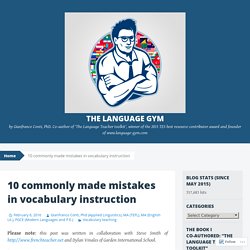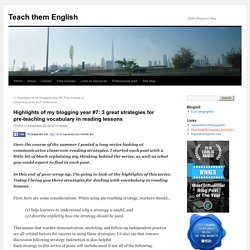

Word Booster. 10 commonly made mistakes in vocabulary instruction. Please note: this post was written in collaboration with Steve Smith of and Dylan Vinales of Garden International School.

In this post I will concern myself with ten very common pitfalls of vocabulary instruction and with ways in which they can be easily pre-empted. Mistake1 – Shallow encoding practices As already mentioned in many previous posts of mine, a to-be-learnt word lingers in our Working Memory for no longer than two or three seconds immediately after we hear it. Thus, in order to commit it effectively to Long-term Memory, we must perform some form of rehearsal. Rehearsal involves either ‘shallow’ or ‘deep’ processing. In shallow processing we use repetition or matching a word to a visual cue. Example: if you taught your students ten words using some of the www.linguascope.com very entertaining games (e.g. matching words to pictures; word dictation; spelling games), they will have performed lots of fun activities for 10-15 minutes. Mistake 2 – Limited contextualized practice. WordWriter. 3 great strategies for pre-teaching vocabulary in reading lessons.
Over the course of the summer I posted a long series looking at communicative classroom reading strategies.

I started each post with a little bit of blurb explaining my thinking behind the series, as well as what you could expect to find in each post. In this end of year wrap-up, I’m going to look at the highlights of this series. Today I bring you three strategies for dealing with vocabulary in reading lessons. First, here are some considerations: When using any teaching strategy, teachers should… (1) help learners to understand why a strategy is useful, and (2) describe explicitly how the strategy should be used.
This means that teacher demonstration, modeling, and follow-up independent practice are all critical factors for success in using these strategies. Advice on how to implement the strategy in your classesExamplesConsiderations for second language learners, students of varying reading skill, and younger learnersThe supporting research / recommended further reading Sound OK to you? Great reading strategies: ‘Word Maps’ for dealing with important vocabulary. Over the course of this summer I’m going to be posting a long series looking at communicative classroom reading strategies.

I’ll start each post with this little bit of blurb explaining my thinking behind the series, as well as what you can expect to find in each post. as this is the first post of the series, please read on (although you should probably skip this section in subsequent posts). As far as I’m concerned, when implementing strategy training of this kind in your classes teacher demonstration, modeling, and follow-up independent practice are all critical factors for success. I’d also say that learner discussion following strategy instruction is also helpful. For more on what I consider to be fundamental considerations in using reading strategies, please take a look at the opening paragraphs in the first post in this series.
Each strategy in this series of posts will include most if not all of the following: Sound OK to you? 2. So, why use word maps? Example Baumann, J.